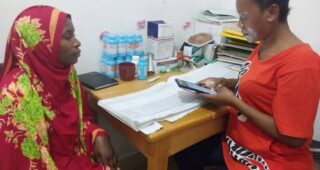Never Going Back
Jackline Atieno, a volunteer health worker in Homabay County, Kenya, recalls that not so long ago, much of her time was taken up by completing paperwork when she would rather be counseling women. As a peer educator at the comprehensive care clinic within Lwanda Gwasii dispensary, she hails the recent introduction of electronic medical records (EMR), which are stored in the Cloud
“Before we started using the EMR, our work was labor intensive, especially at the HIV clinic,” says Jackline. “We were required to fill many forms in addition to the other register. And retrieval of patient files was very hard sometimes.”
“The EMR system reduced our headache. With it, we only need to either register new patients in the systems or search for a patient within the existing files where their information is readily available.”
 Healthcare workers in Kenya reviewing electronic medical records. Photo by Charity Mureithi / EGPAF 2022.
Healthcare workers in Kenya reviewing electronic medical records. Photo by Charity Mureithi / EGPAF 2022.
In coordination with Kenya’s Ministry of Health, the Elizabeth Glaser Pediatric AIDS Foundation (EGPAF) is pioneering this EMR system for 161 supported health facilities under the Vukisha 95 Project, co-implemented with LVCT Health. EGPAF has been digitizing health records and is collecting real-time data on HIV and TB in Homabay County. Recently, the organization has also started supporting Kiambu County with COVID-19 data in 30 health facilities.
“Prior to the EMR roll-out, I had at least 22 files to wade through to serve a single patient at the clinic,” points out Jackline. “This has since changed because at the click of a button I am able to access the data and link the patient to services. It saves on time and has supported proper case management since all patient information and records are available.”
Savings in Time, Quicker Decisions
 A laboratory staff member at Magunga Level 4 Hospital shares end-user experience with Ministry of Health officials during a visit to the facility. Photo by Charity Mureithi/Elizabeth Glaser Pediatric AIDS Foundation, 2022
A laboratory staff member at Magunga Level 4 Hospital shares end-user experience with Ministry of Health officials during a visit to the facility. Photo by Charity Mureithi/Elizabeth Glaser Pediatric AIDS Foundation, 2022
Not only does the Cloud EMR system increase quality time with patients in a facility, it also makes it easier for administrators to manage their tasks without spending hours on the road.
“With the EMR system, I am able to perform my support supervisory roles remotely and offer assistance as opposed to the past when I had to physically visit the sites every so often to get work done,” says Nancy Kulei, the AIDS and STI coordinator for Rangwe Sub-County. This helps her prioritize and better support those facilities in greater need.
“The system has benefited the facility by making it easy to generate reports that are utilized by teams in decision making,” notes Wycliffe Onyango, the in-charge clinician at Magunga Level 4 Hospital. “The system has been instrumental in reminding me of the patients who are due for review, through the appointments alert feature embedded in the system.
“We are not willing to get back to where we began from as a facility, and will do all it takes to ensure the system is working optimally to improve care for our patients,” he says.
Challenges
 Some of the staff at Ngegu Dispensary during a Ministry of Health visit organized by EGPAF. Photo by Charity Mureithi/Elizabeth Glaser Pediatric AIDS Foundation, 2022
Some of the staff at Ngegu Dispensary during a Ministry of Health visit organized by EGPAF. Photo by Charity Mureithi/Elizabeth Glaser Pediatric AIDS Foundation, 2022
Dr. Gerald Akeche, the Ministry’s chief office in Homabay County, points out that while “data is very critical to informing decisions,” some health care workers remain reticent to embrace digitization. He underscored the need for continued education and training to help make the leap from paper to electronic tablets.
And in some facilities, health care workers still rely on manual records to support the system, which is still being built out. At the mother-child health clinic, there are missing modules and some records have to be taken manually for cross-referencing with the system.
Blazing the Way for a National Digital Health Platform
During a recent learning visit by the Ministry of Health, officials lauded EGPAF and sought to gain insights as they plan to scale up Cloud EMR into a national digital health platform. At Ngegu Dispensary in Rangwe Sub-County, the clinical teams shared its benefits with the visiting team. The facility is implementing Cloud EMR in all points of care with coverage projected to be over 90% across all departments.
 Rahab Ndungú a community health volunteer keys patient data into the electronic medical records system at Ngoliba Health Center, one of the project study sites. Photo by Charity Mureithi/Elizabeth Glaser Pediatric AIDS Foundation, 2022
Rahab Ndungú a community health volunteer keys patient data into the electronic medical records system at Ngoliba Health Center, one of the project study sites. Photo by Charity Mureithi/Elizabeth Glaser Pediatric AIDS Foundation, 2022
“We have heard of the good things that you are doing here in Homabay and we have come to see for ourselves,” said Victor Kimathi, an information and communication technology official at the Division of National AIDS and STI Control Program (NASCOP).
“With the support of EGPAF, we have been able to digitize health records using the point-of-care EMR system and have gotten rid of the paperwork that existed before.”
“Homabay County is one of the counties that bear the brunt of HIV/AIDS. Hence, it was ideal for the roll-out of the Cloud EMR. [This] has proven to be a game changer in delivering quality patient service—in particular in maternal and child health services.”
“With the support of EGPAF, we have been able to digitize health records using the point-of-care EMR system and have gotten rid of the paperwork that existed before,” remarked Dr. Gordon Okomo, the chief health officer in Homabay County. Out of a total of 266 facilities, the partners have connected a total of 165 facilities to the cloud EMR network.
In turn, Dr. Eliud Mwangi, EGPAF-Kenya’s country director, appreciated Homabay County’s Leadership and Health Management team for creating a conducive environment for the institution of Cloud EMR.
Eric Nderitu, the Ministry’s focal person in charge of digitization, called on EGPAF and other players working towards digitizing health to come together and share their data and experiences as the government looks to institute the national digital health platform. He noted that the government is looking to create a hybrid system that allows for health data collection and collation throughout the country
“We are not shutting down the EMRs that exist but we will be looking at ways of merging them,” he said.
Charity Mureithi
Kenya
Strengthening Local Capacity



